Consumer Insight Report: Smart Home Technology, Marketing Strategies
VerifiedAdded on 2022/12/26
|10
|2450
|35
Report
AI Summary
This report delves into the consumer behavior surrounding smart home technology adoption, exploring the market's potential and challenges. It begins with an introduction to smart home technology, outlining its benefits and the increasing consumer interest in home automation. A comprehensive literature review provides an overview of existing research, summarizing key studies and the methodologies employed. The report then applies marketing theories, notably the Theory of Planned Behavior and Self-Determination Theory, to understand consumer attitudes and motivations. Based on this theoretical framework, the report proposes and analyzes three marketing strategies: segmentation, targeting, and positioning. Each strategy is examined in detail, highlighting its advantages, disadvantages, and applicability to the smart home technology market. The report concludes by recommending the most effective strategy and summarizing the key findings, offering valuable insights for businesses aiming to promote and expand the adoption of smart home technologies. The bibliography includes a list of scholarly articles and industry reports.
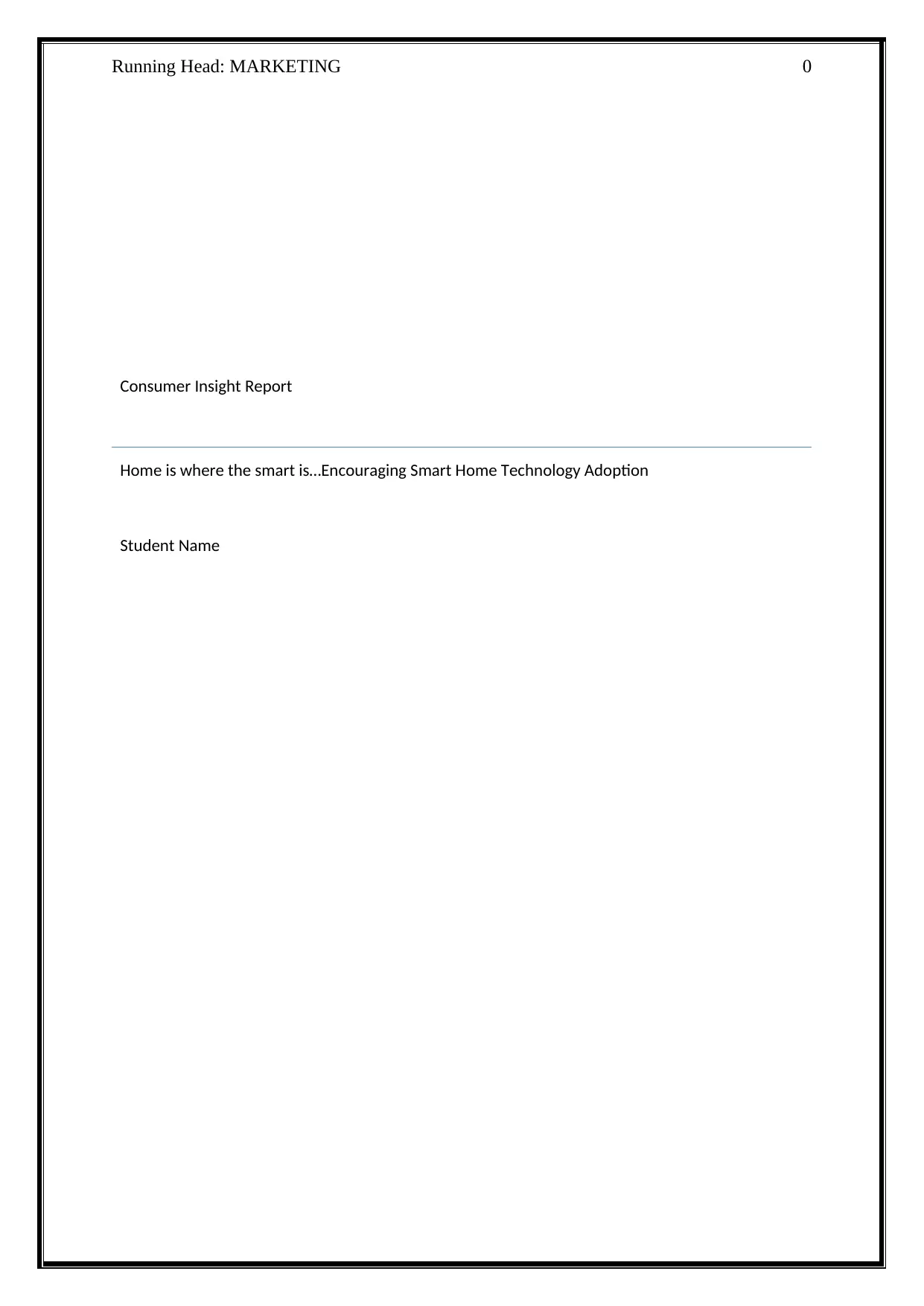
Running Head: MARKETING 0
Consumer Insight Report
Home is where the smart is…Encouraging Smart Home Technology Adoption
Student Name
Consumer Insight Report
Home is where the smart is…Encouraging Smart Home Technology Adoption
Student Name
Paraphrase This Document
Need a fresh take? Get an instant paraphrase of this document with our AI Paraphraser
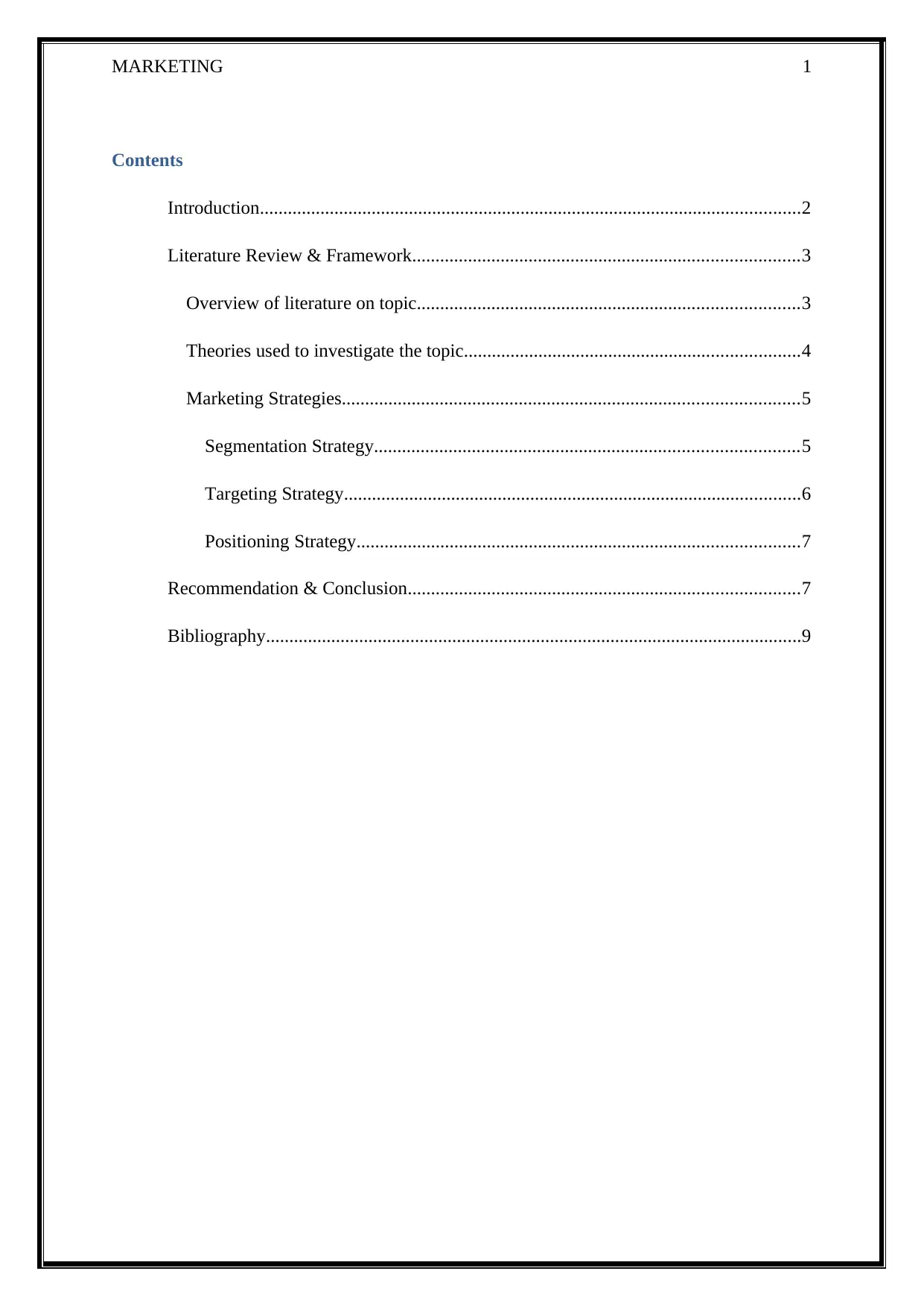
MARKETING 1
Contents
Introduction....................................................................................................................2
Literature Review & Framework...................................................................................3
Overview of literature on topic..................................................................................3
Theories used to investigate the topic........................................................................4
Marketing Strategies..................................................................................................5
Segmentation Strategy...........................................................................................5
Targeting Strategy..................................................................................................6
Positioning Strategy...............................................................................................7
Recommendation & Conclusion....................................................................................7
Bibliography...................................................................................................................9
Contents
Introduction....................................................................................................................2
Literature Review & Framework...................................................................................3
Overview of literature on topic..................................................................................3
Theories used to investigate the topic........................................................................4
Marketing Strategies..................................................................................................5
Segmentation Strategy...........................................................................................5
Targeting Strategy..................................................................................................6
Positioning Strategy...............................................................................................7
Recommendation & Conclusion....................................................................................7
Bibliography...................................................................................................................9
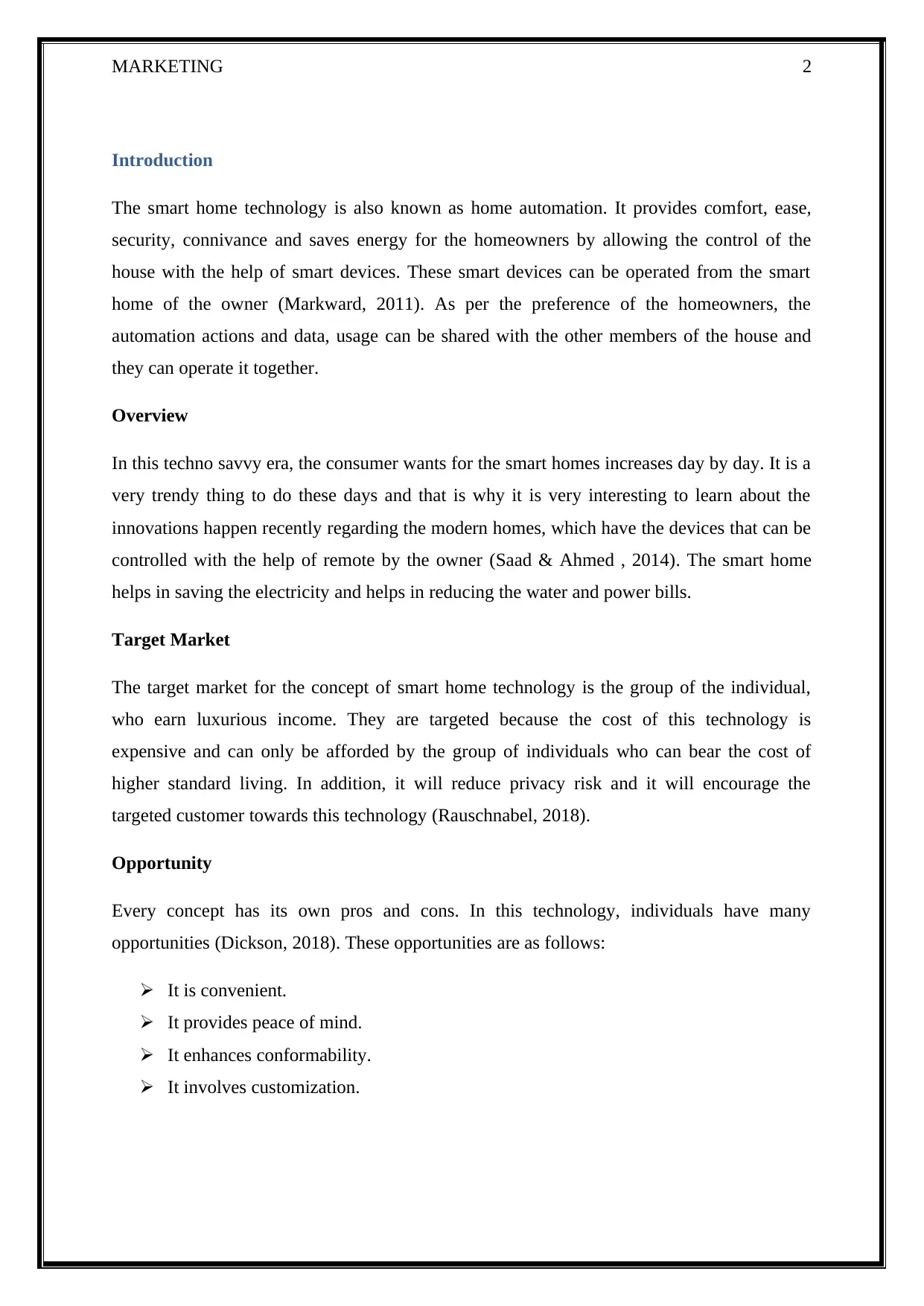
MARKETING 2
Introduction
The smart home technology is also known as home automation. It provides comfort, ease,
security, connivance and saves energy for the homeowners by allowing the control of the
house with the help of smart devices. These smart devices can be operated from the smart
home of the owner (Markward, 2011). As per the preference of the homeowners, the
automation actions and data, usage can be shared with the other members of the house and
they can operate it together.
Overview
In this techno savvy era, the consumer wants for the smart homes increases day by day. It is a
very trendy thing to do these days and that is why it is very interesting to learn about the
innovations happen recently regarding the modern homes, which have the devices that can be
controlled with the help of remote by the owner (Saad & Ahmed , 2014). The smart home
helps in saving the electricity and helps in reducing the water and power bills.
Target Market
The target market for the concept of smart home technology is the group of the individual,
who earn luxurious income. They are targeted because the cost of this technology is
expensive and can only be afforded by the group of individuals who can bear the cost of
higher standard living. In addition, it will reduce privacy risk and it will encourage the
targeted customer towards this technology (Rauschnabel, 2018).
Opportunity
Every concept has its own pros and cons. In this technology, individuals have many
opportunities (Dickson, 2018). These opportunities are as follows:
It is convenient.
It provides peace of mind.
It enhances conformability.
It involves customization.
Introduction
The smart home technology is also known as home automation. It provides comfort, ease,
security, connivance and saves energy for the homeowners by allowing the control of the
house with the help of smart devices. These smart devices can be operated from the smart
home of the owner (Markward, 2011). As per the preference of the homeowners, the
automation actions and data, usage can be shared with the other members of the house and
they can operate it together.
Overview
In this techno savvy era, the consumer wants for the smart homes increases day by day. It is a
very trendy thing to do these days and that is why it is very interesting to learn about the
innovations happen recently regarding the modern homes, which have the devices that can be
controlled with the help of remote by the owner (Saad & Ahmed , 2014). The smart home
helps in saving the electricity and helps in reducing the water and power bills.
Target Market
The target market for the concept of smart home technology is the group of the individual,
who earn luxurious income. They are targeted because the cost of this technology is
expensive and can only be afforded by the group of individuals who can bear the cost of
higher standard living. In addition, it will reduce privacy risk and it will encourage the
targeted customer towards this technology (Rauschnabel, 2018).
Opportunity
Every concept has its own pros and cons. In this technology, individuals have many
opportunities (Dickson, 2018). These opportunities are as follows:
It is convenient.
It provides peace of mind.
It enhances conformability.
It involves customization.
⊘ This is a preview!⊘
Do you want full access?
Subscribe today to unlock all pages.

Trusted by 1+ million students worldwide
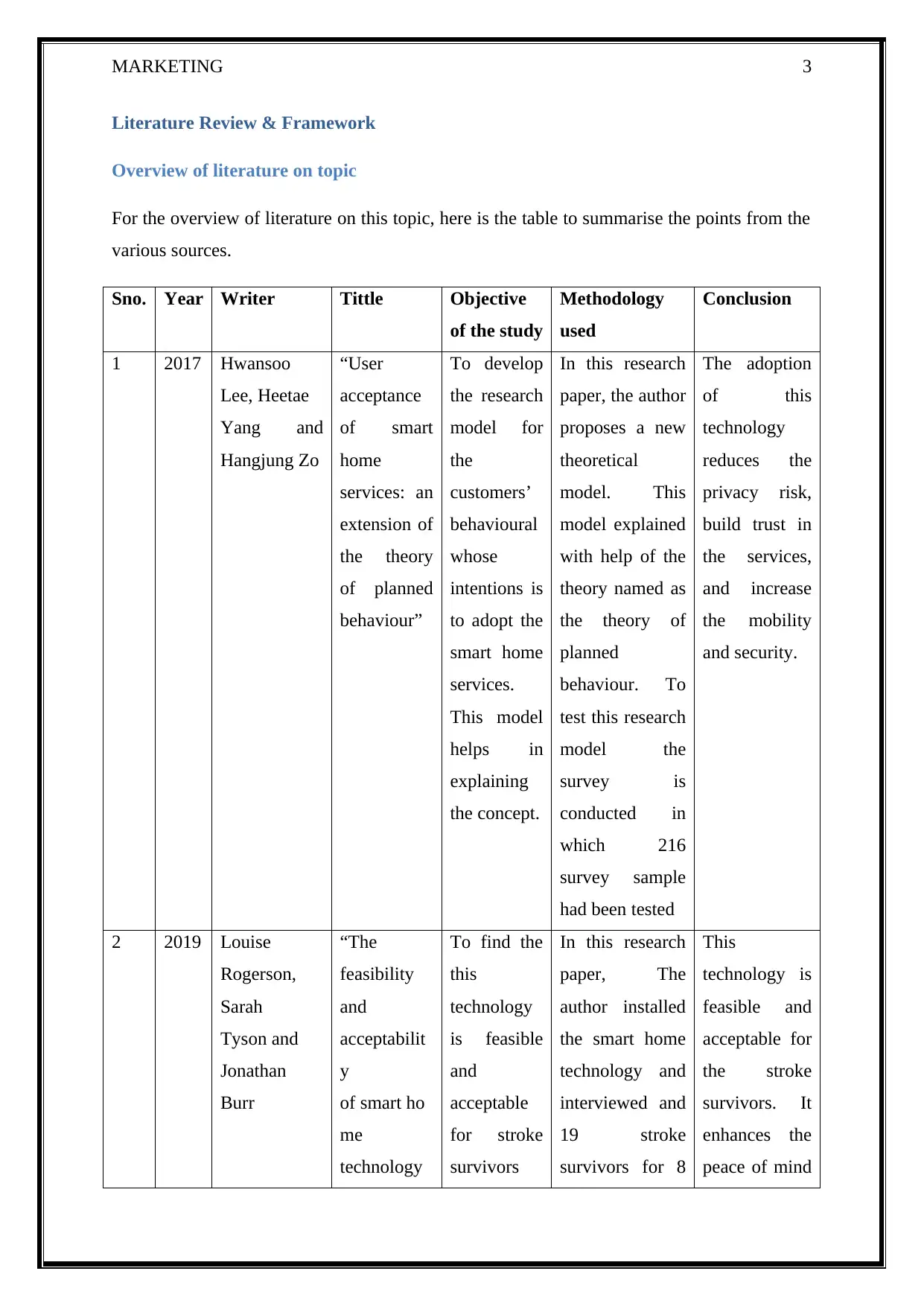
MARKETING 3
Literature Review & Framework
Overview of literature on topic
For the overview of literature on this topic, here is the table to summarise the points from the
various sources.
Sno. Year Writer Tittle Objective
of the study
Methodology
used
Conclusion
1 2017 Hwansoo
Lee, Heetae
Yang and
Hangjung Zo
“User
acceptance
of smart
home
services: an
extension of
the theory
of planned
behaviour”
To develop
the research
model for
the
customers’
behavioural
whose
intentions is
to adopt the
smart home
services.
This model
helps in
explaining
the concept.
In this research
paper, the author
proposes a new
theoretical
model. This
model explained
with help of the
theory named as
the theory of
planned
behaviour. To
test this research
model the
survey is
conducted in
which 216
survey sample
had been tested
The adoption
of this
technology
reduces the
privacy risk,
build trust in
the services,
and increase
the mobility
and security.
2 2019 Louise
Rogerson,
Sarah
Tyson and
Jonathan
Burr
“The
feasibility
and
acceptabilit
y
of smart ho
me
technology
To find the
this
technology
is feasible
and
acceptable
for stroke
survivors
In this research
paper, The
author installed
the smart home
technology and
interviewed and
19 stroke
survivors for 8
This
technology is
feasible and
acceptable for
the stroke
survivors. It
enhances the
peace of mind
Literature Review & Framework
Overview of literature on topic
For the overview of literature on this topic, here is the table to summarise the points from the
various sources.
Sno. Year Writer Tittle Objective
of the study
Methodology
used
Conclusion
1 2017 Hwansoo
Lee, Heetae
Yang and
Hangjung Zo
“User
acceptance
of smart
home
services: an
extension of
the theory
of planned
behaviour”
To develop
the research
model for
the
customers’
behavioural
whose
intentions is
to adopt the
smart home
services.
This model
helps in
explaining
the concept.
In this research
paper, the author
proposes a new
theoretical
model. This
model explained
with help of the
theory named as
the theory of
planned
behaviour. To
test this research
model the
survey is
conducted in
which 216
survey sample
had been tested
The adoption
of this
technology
reduces the
privacy risk,
build trust in
the services,
and increase
the mobility
and security.
2 2019 Louise
Rogerson,
Sarah
Tyson and
Jonathan
Burr
“The
feasibility
and
acceptabilit
y
of smart ho
me
technology
To find the
this
technology
is feasible
and
acceptable
for stroke
survivors
In this research
paper, The
author installed
the smart home
technology and
interviewed and
19 stroke
survivors for 8
This
technology is
feasible and
acceptable for
the stroke
survivors. It
enhances the
peace of mind
Paraphrase This Document
Need a fresh take? Get an instant paraphrase of this document with our AI Paraphraser
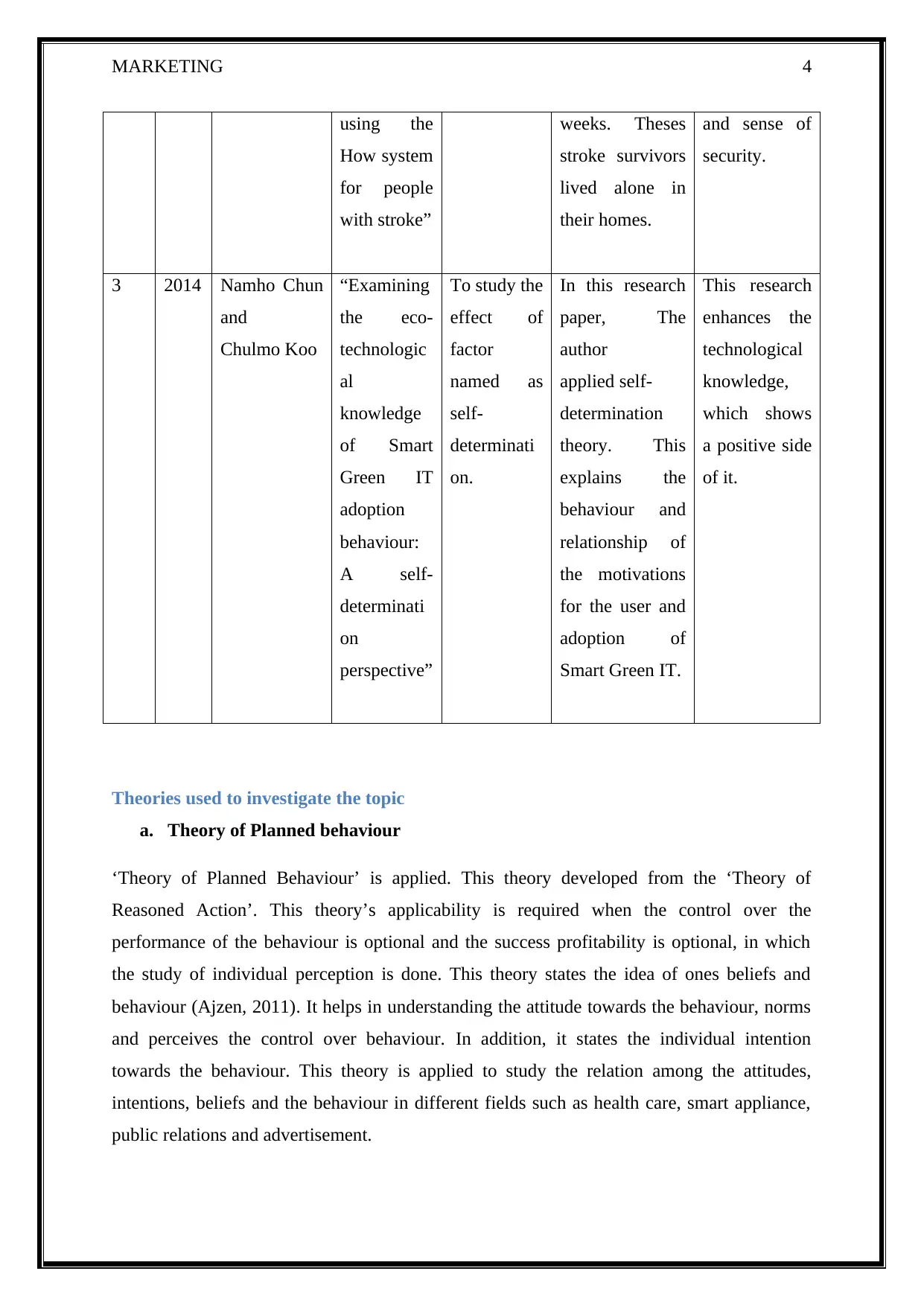
MARKETING 4
using the
How system
for people
with stroke”
weeks. Theses
stroke survivors
lived alone in
their homes.
and sense of
security.
3 2014 Namho Chun
and
Chulmo Koo
“Examining
the eco-
technologic
al
knowledge
of Smart
Green IT
adoption
behaviour:
A self-
determinati
on
perspective”
To study the
effect of
factor
named as
self-
determinati
on.
In this research
paper, The
author
applied self-
determination
theory. This
explains the
behaviour and
relationship of
the motivations
for the user and
adoption of
Smart Green IT.
This research
enhances the
technological
knowledge,
which shows
a positive side
of it.
Theories used to investigate the topic
a. Theory of Planned behaviour
‘Theory of Planned Behaviour’ is applied. This theory developed from the ‘Theory of
Reasoned Action’. This theory’s applicability is required when the control over the
performance of the behaviour is optional and the success profitability is optional, in which
the study of individual perception is done. This theory states the idea of ones beliefs and
behaviour (Ajzen, 2011). It helps in understanding the attitude towards the behaviour, norms
and perceives the control over behaviour. In addition, it states the individual intention
towards the behaviour. This theory is applied to study the relation among the attitudes,
intentions, beliefs and the behaviour in different fields such as health care, smart appliance,
public relations and advertisement.
using the
How system
for people
with stroke”
weeks. Theses
stroke survivors
lived alone in
their homes.
and sense of
security.
3 2014 Namho Chun
and
Chulmo Koo
“Examining
the eco-
technologic
al
knowledge
of Smart
Green IT
adoption
behaviour:
A self-
determinati
on
perspective”
To study the
effect of
factor
named as
self-
determinati
on.
In this research
paper, The
author
applied self-
determination
theory. This
explains the
behaviour and
relationship of
the motivations
for the user and
adoption of
Smart Green IT.
This research
enhances the
technological
knowledge,
which shows
a positive side
of it.
Theories used to investigate the topic
a. Theory of Planned behaviour
‘Theory of Planned Behaviour’ is applied. This theory developed from the ‘Theory of
Reasoned Action’. This theory’s applicability is required when the control over the
performance of the behaviour is optional and the success profitability is optional, in which
the study of individual perception is done. This theory states the idea of ones beliefs and
behaviour (Ajzen, 2011). It helps in understanding the attitude towards the behaviour, norms
and perceives the control over behaviour. In addition, it states the individual intention
towards the behaviour. This theory is applied to study the relation among the attitudes,
intentions, beliefs and the behaviour in different fields such as health care, smart appliance,
public relations and advertisement.
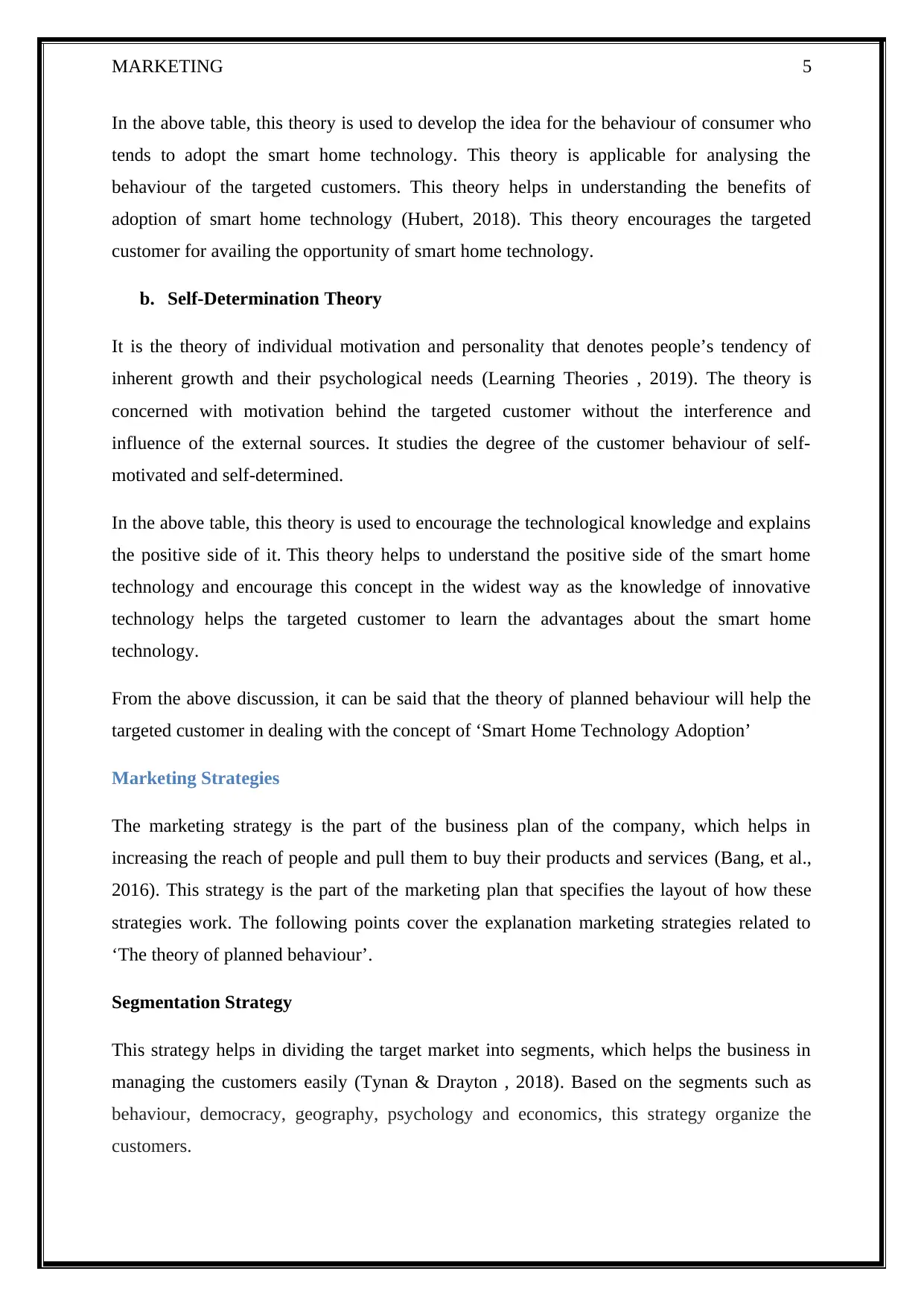
MARKETING 5
In the above table, this theory is used to develop the idea for the behaviour of consumer who
tends to adopt the smart home technology. This theory is applicable for analysing the
behaviour of the targeted customers. This theory helps in understanding the benefits of
adoption of smart home technology (Hubert, 2018). This theory encourages the targeted
customer for availing the opportunity of smart home technology.
b. Self-Determination Theory
It is the theory of individual motivation and personality that denotes people’s tendency of
inherent growth and their psychological needs (Learning Theories , 2019). The theory is
concerned with motivation behind the targeted customer without the interference and
influence of the external sources. It studies the degree of the customer behaviour of self-
motivated and self-determined.
In the above table, this theory is used to encourage the technological knowledge and explains
the positive side of it. This theory helps to understand the positive side of the smart home
technology and encourage this concept in the widest way as the knowledge of innovative
technology helps the targeted customer to learn the advantages about the smart home
technology.
From the above discussion, it can be said that the theory of planned behaviour will help the
targeted customer in dealing with the concept of ‘Smart Home Technology Adoption’
Marketing Strategies
The marketing strategy is the part of the business plan of the company, which helps in
increasing the reach of people and pull them to buy their products and services (Bang, et al.,
2016). This strategy is the part of the marketing plan that specifies the layout of how these
strategies work. The following points cover the explanation marketing strategies related to
‘The theory of planned behaviour’.
Segmentation Strategy
This strategy helps in dividing the target market into segments, which helps the business in
managing the customers easily (Tynan & Drayton , 2018). Based on the segments such as
behaviour, democracy, geography, psychology and economics, this strategy organize the
customers.
In the above table, this theory is used to develop the idea for the behaviour of consumer who
tends to adopt the smart home technology. This theory is applicable for analysing the
behaviour of the targeted customers. This theory helps in understanding the benefits of
adoption of smart home technology (Hubert, 2018). This theory encourages the targeted
customer for availing the opportunity of smart home technology.
b. Self-Determination Theory
It is the theory of individual motivation and personality that denotes people’s tendency of
inherent growth and their psychological needs (Learning Theories , 2019). The theory is
concerned with motivation behind the targeted customer without the interference and
influence of the external sources. It studies the degree of the customer behaviour of self-
motivated and self-determined.
In the above table, this theory is used to encourage the technological knowledge and explains
the positive side of it. This theory helps to understand the positive side of the smart home
technology and encourage this concept in the widest way as the knowledge of innovative
technology helps the targeted customer to learn the advantages about the smart home
technology.
From the above discussion, it can be said that the theory of planned behaviour will help the
targeted customer in dealing with the concept of ‘Smart Home Technology Adoption’
Marketing Strategies
The marketing strategy is the part of the business plan of the company, which helps in
increasing the reach of people and pull them to buy their products and services (Bang, et al.,
2016). This strategy is the part of the marketing plan that specifies the layout of how these
strategies work. The following points cover the explanation marketing strategies related to
‘The theory of planned behaviour’.
Segmentation Strategy
This strategy helps in dividing the target market into segments, which helps the business in
managing the customers easily (Tynan & Drayton , 2018). Based on the segments such as
behaviour, democracy, geography, psychology and economics, this strategy organize the
customers.
⊘ This is a preview!⊘
Do you want full access?
Subscribe today to unlock all pages.

Trusted by 1+ million students worldwide
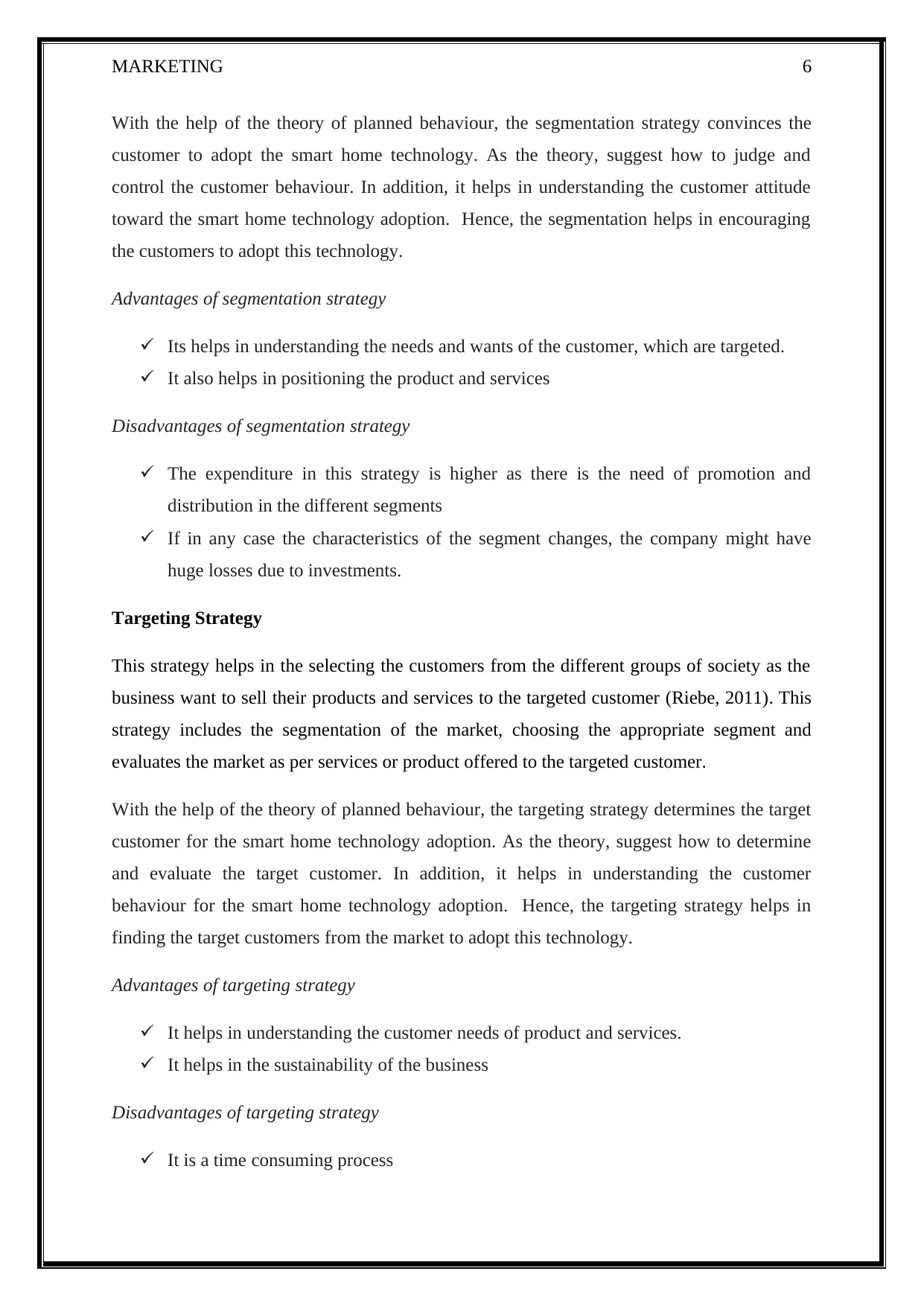
MARKETING 6
With the help of the theory of planned behaviour, the segmentation strategy convinces the
customer to adopt the smart home technology. As the theory, suggest how to judge and
control the customer behaviour. In addition, it helps in understanding the customer attitude
toward the smart home technology adoption. Hence, the segmentation helps in encouraging
the customers to adopt this technology.
Advantages of segmentation strategy
Its helps in understanding the needs and wants of the customer, which are targeted.
It also helps in positioning the product and services
Disadvantages of segmentation strategy
The expenditure in this strategy is higher as there is the need of promotion and
distribution in the different segments
If in any case the characteristics of the segment changes, the company might have
huge losses due to investments.
Targeting Strategy
This strategy helps in the selecting the customers from the different groups of society as the
business want to sell their products and services to the targeted customer (Riebe, 2011). This
strategy includes the segmentation of the market, choosing the appropriate segment and
evaluates the market as per services or product offered to the targeted customer.
With the help of the theory of planned behaviour, the targeting strategy determines the target
customer for the smart home technology adoption. As the theory, suggest how to determine
and evaluate the target customer. In addition, it helps in understanding the customer
behaviour for the smart home technology adoption. Hence, the targeting strategy helps in
finding the target customers from the market to adopt this technology.
Advantages of targeting strategy
It helps in understanding the customer needs of product and services.
It helps in the sustainability of the business
Disadvantages of targeting strategy
It is a time consuming process
With the help of the theory of planned behaviour, the segmentation strategy convinces the
customer to adopt the smart home technology. As the theory, suggest how to judge and
control the customer behaviour. In addition, it helps in understanding the customer attitude
toward the smart home technology adoption. Hence, the segmentation helps in encouraging
the customers to adopt this technology.
Advantages of segmentation strategy
Its helps in understanding the needs and wants of the customer, which are targeted.
It also helps in positioning the product and services
Disadvantages of segmentation strategy
The expenditure in this strategy is higher as there is the need of promotion and
distribution in the different segments
If in any case the characteristics of the segment changes, the company might have
huge losses due to investments.
Targeting Strategy
This strategy helps in the selecting the customers from the different groups of society as the
business want to sell their products and services to the targeted customer (Riebe, 2011). This
strategy includes the segmentation of the market, choosing the appropriate segment and
evaluates the market as per services or product offered to the targeted customer.
With the help of the theory of planned behaviour, the targeting strategy determines the target
customer for the smart home technology adoption. As the theory, suggest how to determine
and evaluate the target customer. In addition, it helps in understanding the customer
behaviour for the smart home technology adoption. Hence, the targeting strategy helps in
finding the target customers from the market to adopt this technology.
Advantages of targeting strategy
It helps in understanding the customer needs of product and services.
It helps in the sustainability of the business
Disadvantages of targeting strategy
It is a time consuming process
Paraphrase This Document
Need a fresh take? Get an instant paraphrase of this document with our AI Paraphraser
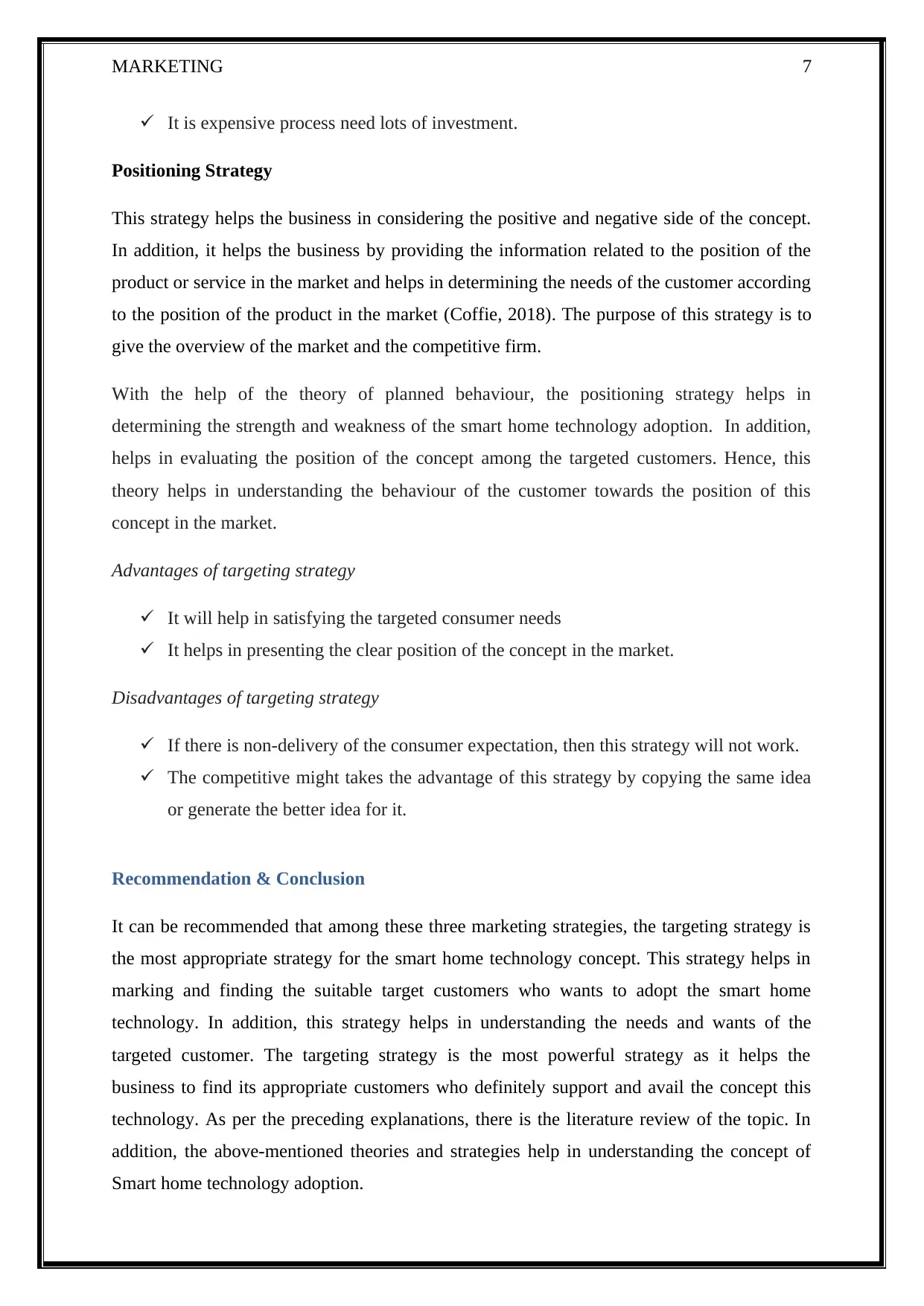
MARKETING 7
It is expensive process need lots of investment.
Positioning Strategy
This strategy helps the business in considering the positive and negative side of the concept.
In addition, it helps the business by providing the information related to the position of the
product or service in the market and helps in determining the needs of the customer according
to the position of the product in the market (Coffie, 2018). The purpose of this strategy is to
give the overview of the market and the competitive firm.
With the help of the theory of planned behaviour, the positioning strategy helps in
determining the strength and weakness of the smart home technology adoption. In addition,
helps in evaluating the position of the concept among the targeted customers. Hence, this
theory helps in understanding the behaviour of the customer towards the position of this
concept in the market.
Advantages of targeting strategy
It will help in satisfying the targeted consumer needs
It helps in presenting the clear position of the concept in the market.
Disadvantages of targeting strategy
If there is non-delivery of the consumer expectation, then this strategy will not work.
The competitive might takes the advantage of this strategy by copying the same idea
or generate the better idea for it.
Recommendation & Conclusion
It can be recommended that among these three marketing strategies, the targeting strategy is
the most appropriate strategy for the smart home technology concept. This strategy helps in
marking and finding the suitable target customers who wants to adopt the smart home
technology. In addition, this strategy helps in understanding the needs and wants of the
targeted customer. The targeting strategy is the most powerful strategy as it helps the
business to find its appropriate customers who definitely support and avail the concept this
technology. As per the preceding explanations, there is the literature review of the topic. In
addition, the above-mentioned theories and strategies help in understanding the concept of
Smart home technology adoption.
It is expensive process need lots of investment.
Positioning Strategy
This strategy helps the business in considering the positive and negative side of the concept.
In addition, it helps the business by providing the information related to the position of the
product or service in the market and helps in determining the needs of the customer according
to the position of the product in the market (Coffie, 2018). The purpose of this strategy is to
give the overview of the market and the competitive firm.
With the help of the theory of planned behaviour, the positioning strategy helps in
determining the strength and weakness of the smart home technology adoption. In addition,
helps in evaluating the position of the concept among the targeted customers. Hence, this
theory helps in understanding the behaviour of the customer towards the position of this
concept in the market.
Advantages of targeting strategy
It will help in satisfying the targeted consumer needs
It helps in presenting the clear position of the concept in the market.
Disadvantages of targeting strategy
If there is non-delivery of the consumer expectation, then this strategy will not work.
The competitive might takes the advantage of this strategy by copying the same idea
or generate the better idea for it.
Recommendation & Conclusion
It can be recommended that among these three marketing strategies, the targeting strategy is
the most appropriate strategy for the smart home technology concept. This strategy helps in
marking and finding the suitable target customers who wants to adopt the smart home
technology. In addition, this strategy helps in understanding the needs and wants of the
targeted customer. The targeting strategy is the most powerful strategy as it helps the
business to find its appropriate customers who definitely support and avail the concept this
technology. As per the preceding explanations, there is the literature review of the topic. In
addition, the above-mentioned theories and strategies help in understanding the concept of
Smart home technology adoption.
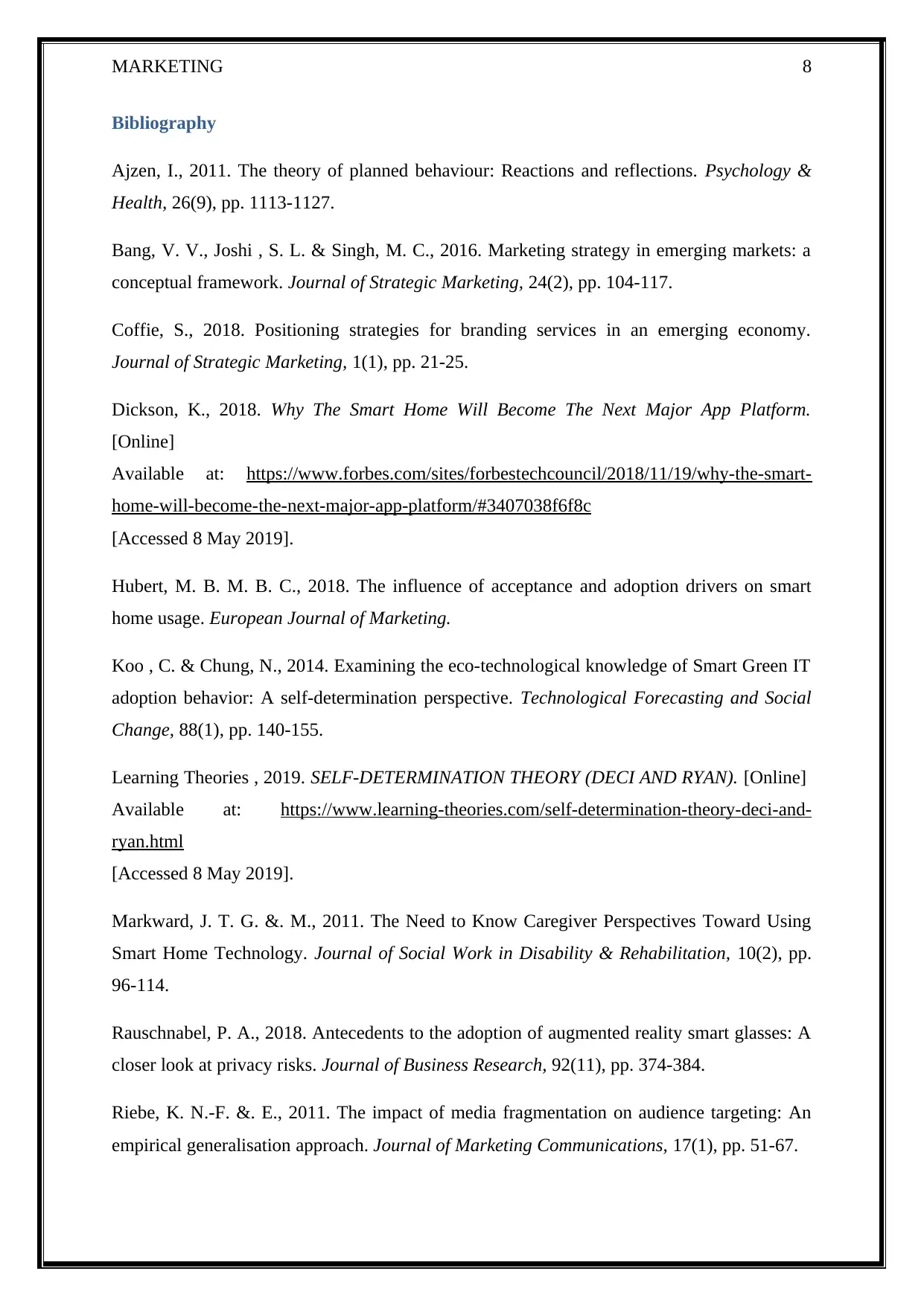
MARKETING 8
Bibliography
Ajzen, I., 2011. The theory of planned behaviour: Reactions and reflections. Psychology &
Health, 26(9), pp. 1113-1127.
Bang, V. V., Joshi , S. L. & Singh, M. C., 2016. Marketing strategy in emerging markets: a
conceptual framework. Journal of Strategic Marketing, 24(2), pp. 104-117.
Coffie, S., 2018. Positioning strategies for branding services in an emerging economy.
Journal of Strategic Marketing, 1(1), pp. 21-25.
Dickson, K., 2018. Why The Smart Home Will Become The Next Major App Platform.
[Online]
Available at: https://www.forbes.com/sites/forbestechcouncil/2018/11/19/why-the-smart-
home-will-become-the-next-major-app-platform/#3407038f6f8c
[Accessed 8 May 2019].
Hubert, M. B. M. B. C., 2018. The influence of acceptance and adoption drivers on smart
home usage. European Journal of Marketing.
Koo , C. & Chung, N., 2014. Examining the eco-technological knowledge of Smart Green IT
adoption behavior: A self-determination perspective. Technological Forecasting and Social
Change, 88(1), pp. 140-155.
Learning Theories , 2019. SELF-DETERMINATION THEORY (DECI AND RYAN). [Online]
Available at: https://www.learning-theories.com/self-determination-theory-deci-and-
ryan.html
[Accessed 8 May 2019].
Markward, J. T. G. &. M., 2011. The Need to Know Caregiver Perspectives Toward Using
Smart Home Technology. Journal of Social Work in Disability & Rehabilitation, 10(2), pp.
96-114.
Rauschnabel, P. A., 2018. Antecedents to the adoption of augmented reality smart glasses: A
closer look at privacy risks. Journal of Business Research, 92(11), pp. 374-384.
Riebe, K. N.-F. &. E., 2011. The impact of media fragmentation on audience targeting: An
empirical generalisation approach. Journal of Marketing Communications, 17(1), pp. 51-67.
Bibliography
Ajzen, I., 2011. The theory of planned behaviour: Reactions and reflections. Psychology &
Health, 26(9), pp. 1113-1127.
Bang, V. V., Joshi , S. L. & Singh, M. C., 2016. Marketing strategy in emerging markets: a
conceptual framework. Journal of Strategic Marketing, 24(2), pp. 104-117.
Coffie, S., 2018. Positioning strategies for branding services in an emerging economy.
Journal of Strategic Marketing, 1(1), pp. 21-25.
Dickson, K., 2018. Why The Smart Home Will Become The Next Major App Platform.
[Online]
Available at: https://www.forbes.com/sites/forbestechcouncil/2018/11/19/why-the-smart-
home-will-become-the-next-major-app-platform/#3407038f6f8c
[Accessed 8 May 2019].
Hubert, M. B. M. B. C., 2018. The influence of acceptance and adoption drivers on smart
home usage. European Journal of Marketing.
Koo , C. & Chung, N., 2014. Examining the eco-technological knowledge of Smart Green IT
adoption behavior: A self-determination perspective. Technological Forecasting and Social
Change, 88(1), pp. 140-155.
Learning Theories , 2019. SELF-DETERMINATION THEORY (DECI AND RYAN). [Online]
Available at: https://www.learning-theories.com/self-determination-theory-deci-and-
ryan.html
[Accessed 8 May 2019].
Markward, J. T. G. &. M., 2011. The Need to Know Caregiver Perspectives Toward Using
Smart Home Technology. Journal of Social Work in Disability & Rehabilitation, 10(2), pp.
96-114.
Rauschnabel, P. A., 2018. Antecedents to the adoption of augmented reality smart glasses: A
closer look at privacy risks. Journal of Business Research, 92(11), pp. 374-384.
Riebe, K. N.-F. &. E., 2011. The impact of media fragmentation on audience targeting: An
empirical generalisation approach. Journal of Marketing Communications, 17(1), pp. 51-67.
⊘ This is a preview!⊘
Do you want full access?
Subscribe today to unlock all pages.

Trusted by 1+ million students worldwide
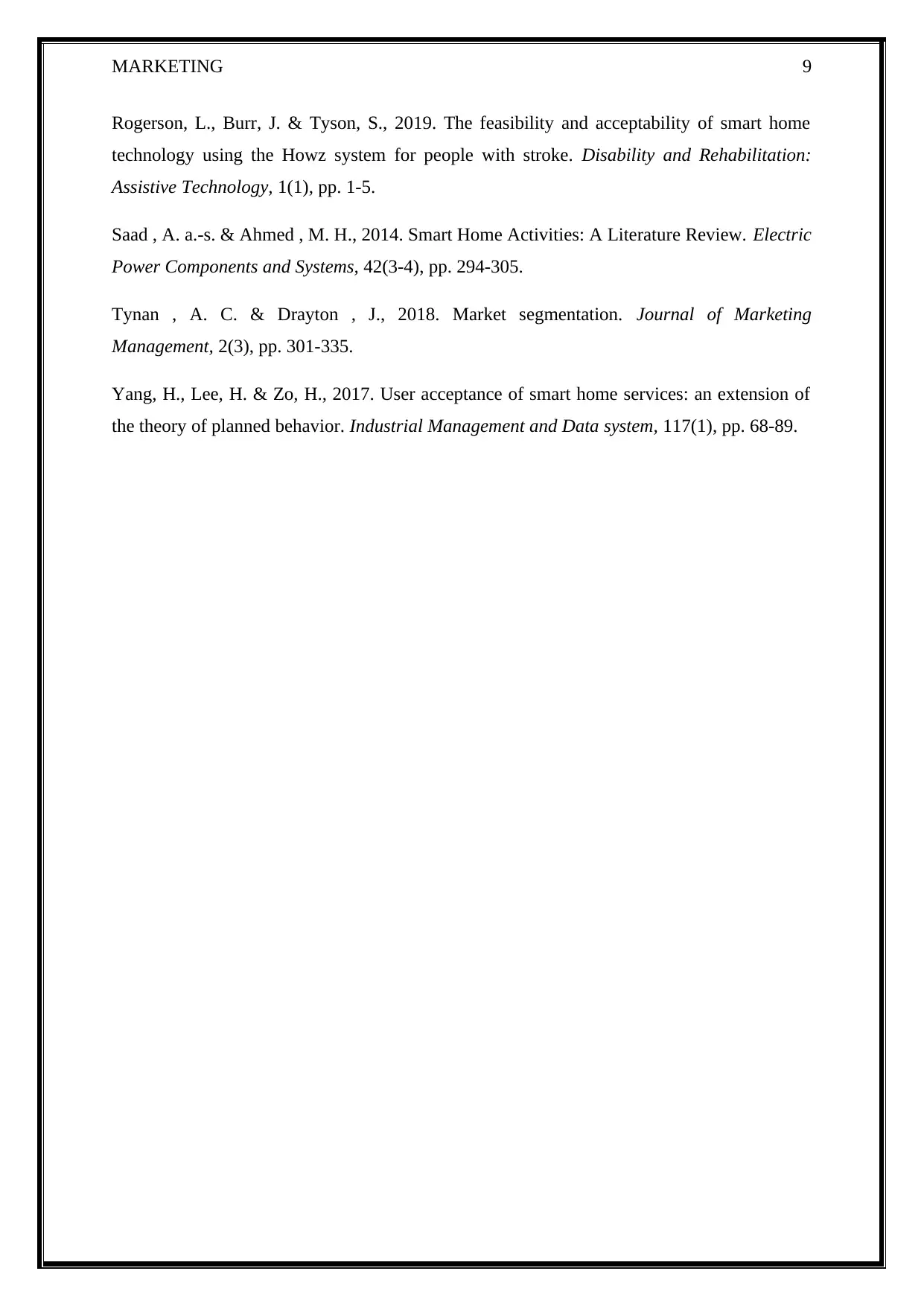
MARKETING 9
Rogerson, L., Burr, J. & Tyson, S., 2019. The feasibility and acceptability of smart home
technology using the Howz system for people with stroke. Disability and Rehabilitation:
Assistive Technology, 1(1), pp. 1-5.
Saad , A. a.-s. & Ahmed , M. H., 2014. Smart Home Activities: A Literature Review. Electric
Power Components and Systems, 42(3-4), pp. 294-305.
Tynan , A. C. & Drayton , J., 2018. Market segmentation. Journal of Marketing
Management, 2(3), pp. 301-335.
Yang, H., Lee, H. & Zo, H., 2017. User acceptance of smart home services: an extension of
the theory of planned behavior. Industrial Management and Data system, 117(1), pp. 68-89.
Rogerson, L., Burr, J. & Tyson, S., 2019. The feasibility and acceptability of smart home
technology using the Howz system for people with stroke. Disability and Rehabilitation:
Assistive Technology, 1(1), pp. 1-5.
Saad , A. a.-s. & Ahmed , M. H., 2014. Smart Home Activities: A Literature Review. Electric
Power Components and Systems, 42(3-4), pp. 294-305.
Tynan , A. C. & Drayton , J., 2018. Market segmentation. Journal of Marketing
Management, 2(3), pp. 301-335.
Yang, H., Lee, H. & Zo, H., 2017. User acceptance of smart home services: an extension of
the theory of planned behavior. Industrial Management and Data system, 117(1), pp. 68-89.
1 out of 10
Related Documents
Your All-in-One AI-Powered Toolkit for Academic Success.
+13062052269
info@desklib.com
Available 24*7 on WhatsApp / Email
![[object Object]](/_next/static/media/star-bottom.7253800d.svg)
Unlock your academic potential
Copyright © 2020–2025 A2Z Services. All Rights Reserved. Developed and managed by ZUCOL.





